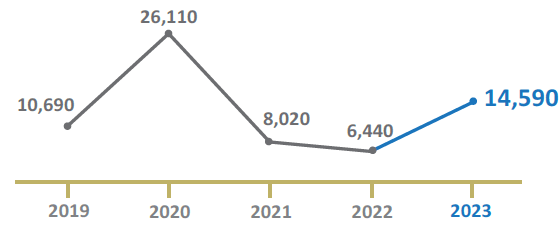Nearly a third of companies plan to increase wages in first quarter of 2024: MOM report
With global headwinds persisting, the Ministry of Manpower (MOM) expects business restructuring and reorganisation to continue, which may contribute to further retrenchments.

People walking in the Central Business District in Singapore on Nov 16, 2022. (File photo: CNA/Hanidah Amin)

This audio is generated by an AI tool.
SINGAPORE: Nearly a third of employers in Singapore plan to increase wages in the first quarter of 2024, said the Ministry of Manpower (MOM) in its latest labour market report on Thursday (Mar 14).
According to company poll results in December 2023, about 32.6 per cent of firms have intentions to raise wages in the first three months of 2024. This is up from the low of 18 per cent in September 2023.
About 47.7 per cent of firms surveyed in December 2023 also have plans to hire in the first three months of this year, up from 42.8 per cent in September last year.
MOM said that its surveys indicate an improvement in business sentiments alongside the Ministry of Trade and Industry’s forecast of improved economic growth prospects for 2024.
However, with global headwinds persisting, it also expects business restructuring and reorganisation to continue, which may contribute to further retrenchments.
RETRENCHMENTS
According to the latest labour market report, retrenchments in Singapore in 2023 were more than double that of the year before – from a record low of 6,440 in 2022 to 14,590 in 2023.
The figure in 2023 is similar to pre-pandemic levels, with the average number of retrenchments for 2015 to 2019 at 14,180.
However the number of firms carrying out retrenchments in 2023 - 1,460 - was higher than the pre-pandemic average of 1,320.
Last year, the incidence of retrenchment was 6.7 per 1,000 employees, up from a rate of 3.1 in 2022.
These figures were broadly in line with the labour market estimates released by MOM in January.
Reorganisation and restructuring of companies remained the top reason for retrenchments in 2023.
The increase in retrenchments was observed across all socio-demographic groups, as well as across industries and occupations, mostly to pre-pandemic norms, MOM said.
Similar to previous years, resident workers formed the majority of retrenchments in 2023. Out of 14,590 retrenched workers, 9,990 were residents, or 68.5 per cent.
In a Facebook post on Thursday, NTUC assistant secretary-general Patrick Tay noted the rise in retrenchments, saying that middle-aged workers in their 40s and 50s, who are mostly professionals, managers, executives and technicians (PMETs), are at highest risk.
"Upskilling and training are critical to help them employable," he said, calling the S$4,000 SkillsFuture top-up scheme and enhanced subsidies for mid-career workers announced at the recent Budget "appropriate" in helping them in their upskilling journey.

About 63.7 per cent of residents who lost their jobs found a new one within six months. This was lower than the 2022 re-entry rate of 68.9 per cent, but comparable to the pre-pandemic range between 2016 and 2019.
"Those who have not found jobs by the six-month mark may still be actively looking for work, while some may choose to leave the labour force voluntarily, with the most common reason being to take a break," said MOM.
About 67.2 per cent of retrenched residents re-entered employment in a different industry, higher than 65.1 per cent in 2022.
“This reflects the transferability of skillsets, as well as the agility and receptivity of workers to new opportunities, as around six in 10 re-entrants received similar or higher wages in their new jobs,” MOM said.
Mr Tay noted the decline in re-entry rate into the workforce among retrenched workers.
"More can be done to improve the mobility of our workers and in particular, our PMETs," he said.
He also noted that a new short-term financial support scheme is in the works for retrenched workers, with more details to be provided later this year.
The number of job vacancies also rose slightly to 79,800 in December 2023, up from 78,200 in September 2023. This comes after six consecutive quarters of decline from the peak of 124,400 in March 2022.
INFORMATION AND COMMUNICATIONS SECTOR
Retrenchments in 2023 were mainly in outward-oriented services sectors such as wholesale trade, information and communications, professional services, financial services, and electronics manufacturing, reflecting their exposure to global economic headwinds.
The electronics manufacturing sector saw the highest incidence of retrenchment last year, at 27.5 per 1,000 employees, followed by the information and communications sector at a rate of 24.9 per 1,000 workers.
The majority of retrenchments in the information and communications sector were due to reorganisation or restructuring, as firms "rationalised their manpower after the surge in hiring in previous years".
"These firms could also be restructuring their operations to focus on new and longer-term growth areas, as vacancies remained high in the sector," said MOM in its report.
Workers retrenched from the information and communications sector had one of the highest re-entry rates, at 70.3 per cent.
TOTAL EMPLOYMENT
Total employment grew by 88,400 in 2023, with the increase largely driven by non-residents, especially in the construction and manufacturing sectors, MOM said. Resident employment growth was mainly in financial services and professional services.
In the fourth quarter of 2023, total employment expanded for the ninth consecutive quarter by about 7,500, with the vast majority being non-residents.
This increase has “moderated significantly” from the 23,600 in the third quarter of 2023.
“The moderation was not unexpected as weaker hiring expectations and declining job vacancies from previous quarters indicated cooling labour demand,” MOM said.
Unemployment rates remained stable and low in December 2023, with the overall unemployment rate at 2 per cent, the resident rate at 2.8 per cent and the citizen rate at 2.9 per cent.
"Amid global economic uncertainties, MOM will work hand-in-hand with Singaporeans to sustain economic competitiveness and help workers take on better jobs," said the ministry.
Mr Tay, in his Facebook post, noted that the increase in total employment in 2023 was primarily driven by non-residents.
"To attract more Singaporeans to join certain sectors, we should consider more structured career progression models with better wages and work prospects so that we can attract more Singaporeans," he said.

















